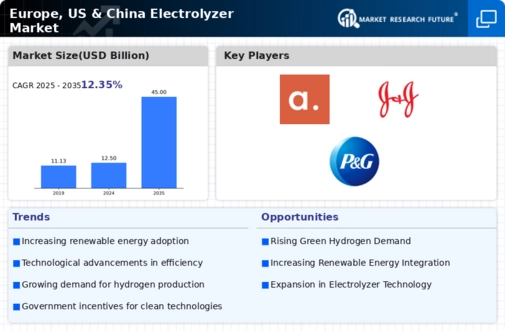Market Share
Europe US China Electrolyser Market Share Analysis
Each region including the Europe, US and China electrolyser markets is witnessing distinct market share positioning strategies as each strives for relative dominance in the flourishing hydrogen economy. Europe is a proactive region when it comes to adopting renewable energy, stringent environmental regulations have helped the electrolyser market grow. To aid with carbon neutrality in the European region, market players are concerned about developing innovative advanced electrolysis technologies to produce green hydrogen. The companies are taking advantage of renewable energy providers partnership and government incentives to improve their market realities. Having a collaborative ecosystem, Europe is placing itself as the global leader in sustainable hydrogen production. The market share positioning strategies for electrolyser technologies in the United States are highly influenced by a mixture of strong government programs along with ability and inventiveness from private sector. The favorable environment for electrolyser manufacturers has been fostered by the emphasis of the Biden administration on clean energy and infrastructure development. With the help of federal funding, tax credits, and research grants investors use this opportunity to promote electrolysis projects faster. Further, important partnerships with the critical stakeholders including energy utilities and industrial customers play a pivotal role in defining market dynamics. The U.S. electrolyser market is positioning as an important part of the global hydrogen value chain. However, in China the electrolyser market is driven by a strong manufacturing base spurred on by Beijing’s desire to become world leader in hydrogen. China investment in hydrogen technologies has been driven by the efforts to attain energy security, reduce dependence on fossil fuels and address environmental issues. The main concerns of domestic companies are mass production and cost efficiency in order to cover a major share of the market. Government initiatives, research, and development projects as well as a wide network of collaboration between public entities and private firms Boost China’s dominance in the electrolyser market. By focusing on technologies and scale, China wants to control the international hydrogen landscape. The positioning strategies of each region’s market share are informed by its unique combinations of policy framework, industry partnerships and advancements in technology. In Europe, emphasis is made on sustainability and with its green energy objectives while the United States combines government support for private sector innovation as a driving force of electrolyser market. Contrastingly, China prioritizes on the size and efficiency to become a major player in worldwide hydrogen economy. With these regions moving forward to develop their respective electrolyser markets, the global scene is transforming towards a more sustainable and connected hydrogen industry wherein each region contributes its competitive strengths in advancing it.






Leave a Comment